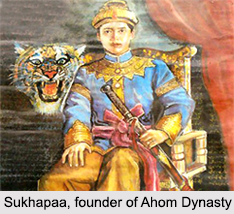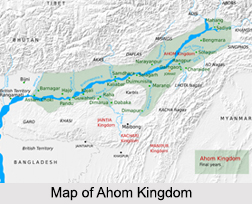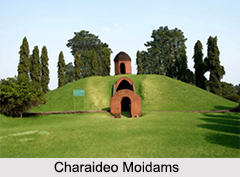 Ahom dynasty comprised the rulers of Ahom kingdom of Assam. Sukaphaa had established this dynasty which lasted for about 600 years. Sukaphaa was a Shan prince of Mong Mao who travelled for a long period of time, crossed Patkai mountains and finally reached Assam. The rule of Ahom dynasty came to an end with the invasion of Burmese in Assam and later in 1826 owing to the `Treaty of Yandabo` which led to the annexation of the region by British East India Company. `Asam Raja` was the name given to the kings belonging to Ahom dynasty in medieval chronicles. The people of the kingdom used to call them `Chaopha` or `Swargadeo`.
Ahom dynasty comprised the rulers of Ahom kingdom of Assam. Sukaphaa had established this dynasty which lasted for about 600 years. Sukaphaa was a Shan prince of Mong Mao who travelled for a long period of time, crossed Patkai mountains and finally reached Assam. The rule of Ahom dynasty came to an end with the invasion of Burmese in Assam and later in 1826 owing to the `Treaty of Yandabo` which led to the annexation of the region by British East India Company. `Asam Raja` was the name given to the kings belonging to Ahom dynasty in medieval chronicles. The people of the kingdom used to call them `Chaopha` or `Swargadeo`.
Swargadeo of Ahom Dynasty
The first king of Ahom dynasty was Sukaphaa. He ruled over the Ahom kingdom from 1228 to 1268 AD. Succession of throne was determined by agnatic primogeniture in the kingdom. Only the descendents of Sukaphaa were eligible to become the kings but were not eligible to hold ministerial positions. This division of power was constant throughout the rule of Ahom dynasty. Once Atan Burhagohain was asked to be the king for Swargadeo, by the nobles, but the idea was strongly opposed by the Tai priests.
Previously kings of Ahom kingdom were usually appointed with the agreement of the Council of Ministers also known as `Patra Matris` which comprised the Borgohain, Borbarua, Burhagohain, Borpatrogohain and Borphukan. In 14th century, during three periods, the kingdom was devoid of any King owing to unavailability of deserving candidates for Kingship. The ministers also had the power to remove the unworthy kings from the throne by executing them. A great struggle for power arose in 17th century when the number of claimants to the throne increased which resulted in quick successions and execution of the former kings. To stop this brutal war of succession, a new rule was formulated during the reign of Sulikphaa Lora Roja according to whom the king had to be unblemished physically. To counteract this rule, new tricks were devised which involved slitting the ear of the next probable king. When Sukhrungphaa, also known as Rudra Sinha, visualized his brother Lechai as a threat, he mutilated his brother and sent him to some far off place. To solve further problem of succession, Rudra Sinha in his deathbed ordered all his sons to become the king. However, one of his sons known as Mohanmala was superseded by the others and consequently Mohanmala revolted against them with a group in the Moamoria rebellion. The unblemished rule was followed by the later kings and officials. Legends of Ahom kingdom say that Sukaphaa was the descendant of God Khunlung and thus the kings were believed to be of divine origin.
 Coronation in Ahom Dynasty
Coronation in Ahom Dynasty
Coronation of Ahom kings or Swargadeo was done in a special ceremony known as Singarigharutha. The ceremony was first performed by Sudangphaa. On this occasion, the first coins bearing the name of the new king were minted. Coronations of Kamaleswar Singha (1795 to 1811 AD) and Chandrakanta Singha (1811 to 1818 AD) were skipped on account of financial constraints caused due to Moamoria rebellion. This was suggested by the Prime Minister, Purnananda Burhagohain. After the demise of the kings, they were buried at Charaideo in vaults, also known as Moidam. In 17th century many of the Moidams were robbed by Mir Jumla. In the later period, some of the kings including Rajeswar Singha (1751 to 1769 AD) were cremated and their ashes were buried in the Moidams.
Queens of Ahom Dynasty
Ahom Queens had significant positions in state affairs. They were given gradation of positions which determined their official designations as Bor Kuwori, Raidangia Kuwori, Parvatia Kuwori, Tamuli Kuwori and many more who were the daughters of officials and nobles of the kingdom. Chamua kunworis was the name given to the lesser wives of Ahom kings. Separate estates were assigned to some queens and care was bestowed on them by state officials also known as Baruas and Phukans. Most of the times, the Queens also maintained the office after the removal or death of kings.
Customs of Ahom Dynasty
As per Ahom traditions, the king had to adopt an Ahom name. The name would be suggested by the priests of the kingdom. The names usually ended with "Pha". Kings of the later period however also adopted Hindu names that ended with Singha. Chomdeo was considered as the deity of kingdom during the reign of Swargadeo Sukaphaa. The king also had several classes of priests known as Bailung, and Deodhai etc. Religion and customs had great impact on the Ahom kingdom.
 Royal Houses in Ahom Dynasty
Royal Houses in Ahom Dynasty
In Ahom dynasty, Subinphaa (1281 to 1293AD) had delineated seven houses. Out of these, the first lineage comprised of the kings, next two were of Borgohain and Burhagohain and the rest four were priestly lineages. The position of `Charing Raja` was established by Sukhramphaa (1332 to 1364 AD) for the heir apparent. This position was firstly occupied by Chao Pulai, Sukhramphaa`s half brother, but he could not finally acquire the position of the king. Descendants of the earlier kings were settled by Suhungmung Dihingia Raja (1497 to 1539 AD) and he assigned them seven royal houses viz. Tipamiya, Saringiya, Samuguriya, Dihingiya, Parvatiya, Tungkhungiya and Namrupiya. The distinct periods of Ahom dynasty later was recognized by these names. The kings of the kingdom were guarded by six thousand soldiers under a Bhitarual Phukan. Sukhamphaa Khora Raja had also created a unit of musketeers which comprised of the relatives of the king. They were the protectors of the palace, the capital and environs.



















